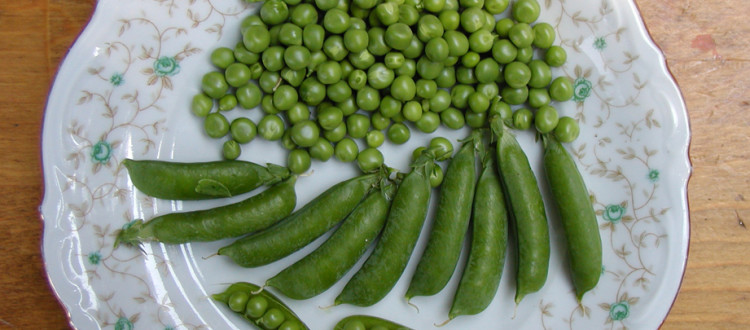Peas
Podded peas (Pisum sativa) are an annual plant that produces slender pods, each containing several peas. This plant grows best in cooler temperatures, and is botanically classified as a fruit.
The history of the pea dates back to as early as 4,800 BC in the eastern Mediterranean. When famine hit Europe in the Middle Ages, peas were one of the few foods available to people.
Peas are grown either as a bush or as a vine, and most cultivars reach maturity within 60 days of transplanting. They do not tolerate summer heat so they are typically planted in early spring or fall, depending on the planting location and climate. They are considered a starch, but peas are also high in fiber, protein, Vitamins A, B6 and a number of trace minerals. An extra benefit of planting peas in the garden is their ability to fix nitrogen in the soil.
Edible Pod Peas
Edible pod peas have similar growing conditions to podded peas, but they are ready for harvest earlier than podded peas. Snow peas are peas that have a tender edible shell or pod and are used in Asian cuisine. Tall climbing varieties will give you a bountiful harvest and staggered plantings will give you an extended harvest. If spring warms up quickly in your area, the shorter or dwarf vines will yield sooner and are recommended. Harvest the snow peas before they fill out. The peas within are usually (with few exceptions) very starchy and tasteless. Snow peas are sometimes also called sugar peas. These are not to be confused with sugar snap peas, which have a plump, crunchy sweet pod.
Sugar Snap Peas
Sugar snap peas are sometimes called snap peas. Sugar snap peas are a hybrid of a snow pea crossed with a mutant shelling pea plant developed by Dr. Lamborn and Dr Parker of Twin Falls Idaho in the 1960s. They require similar growing conditions as snow peas, and are available as dwarf or tall vines as well. Wait for the pods to fill out completely before harvesting, as that is when they will be at their sweetest. When they reach that stage, pick them right away and enjoy as soon as possible. They are delicious eaten fresh as a snack, or quickly cooked in a stir-fry ever so slightly.
How to Plant
Peas thrive in loose, loamy soil that doesn’t stay wet. Young pea plants can tolerate frost, even snow, but not extreme freezing temperatures for period of several days or more. Peas are a snap to grow, requiring little more than water, sunshine and cool temperatures. Plant about 5 inches apart in soil that is at least 45 degrees.
All varieties benefit from growing on some type of support such as a trellis, fence or some other structure. Put your support structure in place when planting as the pea vine uses tendrils to attach to it. These supports make it easier to harvest the pods.
Peas fix nitrogen by bonding with rhizobium bacteria, which occurs naturally in most soils. If you have doubts about your garden plot having these bacteria, purchase a rhizobium inoculant at your local garden store and work it into the soil before planting.
Fertilizing
Legumes such as peas don’t require a lot of fertilizer, but will benefit from fertilizers high in phosphorus and potassium. Avoid using too much nitrogen.
Harvesting
Knowing the right time to harvest your pea crop depends on what you see and feel. If the pod is shiny and rounded, the pod is ready. Use caution when picking the pod from the plant, as peas have a shallow root structure, making it susceptible to being uprooted if a strong tug is used.
Once the pea plant begins producing, pick the pods frequently, such as every other day. This will boost yields. Leaving ripe pods on the vine will decrease production.
Recommended Uses
- Peas are their height of flavor the moment they are picked.
- Boiling the peas in as little water as possible for as short a time as possible helps retain the starches and sugars. Avoid overcooking.
- Peas can be dried or frozen, but suffer from some loss of flavor.
- Dried peas are an excellent addition to soups and casseroles.

